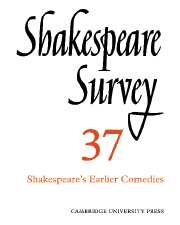Book contents
- Frontmatter
- Criticism of the Comedies up to The Merchant of Venice: 1953–82
- Plotting the Early Comedies: The Comedy of Errors, Love’s Labour’s Lost, The Two Gentlemen of Verona
- The Good Marriage of Katherine and Petruchio
- Shrewd and Kindly Farce
- Illustrations to A Midsummer Night’s Dream before 1920
- The Nature of Portia’s Victory: Turning to Men in The Merchant of Venice
- Nature’s Originals: Value in Shakespearian Pastoral
- 'Contrarieties agree': An Aspect of Dramatic Technique in Henry VI
- Falstaff’s Broken Voice
- ‘He who the sword of heaven will bear’: The Duke versus Angelo in Measure for Measure
- War and Sex in All’s Well That Ends Well
- Changing Places in Othello
- Prospero’s Lime Tree and the Pursuit of Vanitas
- Shakespearian Character Study to 1800
- How German is Shakespeare in Germany? Recent Trends in Criticism and Performance in West Germany
- Shakespeare Performances in Stratford upon–Avon–and London, 1982–3
- The Year's Contributions to Shakespearian Study 1 Critical Studies
- 2 Shakespeare’s Life, Times and Stage
- 3 Editions and Textual Studies
- Index
'Contrarieties agree': An Aspect of Dramatic Technique in Henry VI
Published online by Cambridge University Press: 28 March 2007
- Frontmatter
- Criticism of the Comedies up to The Merchant of Venice: 1953–82
- Plotting the Early Comedies: The Comedy of Errors, Love’s Labour’s Lost, The Two Gentlemen of Verona
- The Good Marriage of Katherine and Petruchio
- Shrewd and Kindly Farce
- Illustrations to A Midsummer Night’s Dream before 1920
- The Nature of Portia’s Victory: Turning to Men in The Merchant of Venice
- Nature’s Originals: Value in Shakespearian Pastoral
- 'Contrarieties agree': An Aspect of Dramatic Technique in Henry VI
- Falstaff’s Broken Voice
- ‘He who the sword of heaven will bear’: The Duke versus Angelo in Measure for Measure
- War and Sex in All’s Well That Ends Well
- Changing Places in Othello
- Prospero’s Lime Tree and the Pursuit of Vanitas
- Shakespearian Character Study to 1800
- How German is Shakespeare in Germany? Recent Trends in Criticism and Performance in West Germany
- Shakespeare Performances in Stratford upon–Avon–and London, 1982–3
- The Year's Contributions to Shakespearian Study 1 Critical Studies
- 2 Shakespeare’s Life, Times and Stage
- 3 Editions and Textual Studies
- Index
Summary
Half-way through the Henry VI trilogy, as Jack Cade’s army swarms into London, the Lord Mayor sends to the Tower for help against the rebels. Lord Scales replies that while he is very willing to help, ‘I am troubled here with them myself’ (Part Two, 4.5.7); he suggests instead that the citizens should gather head in Smithfield, ‘And thither I will send you Matthew Gough’ (4.5.10). This, as it turns out, is no great help, for twenty lines later, after a brief intervening scene for Cade, there comes the terse stage direction: ‘Alarums. Matthew Gough is slain, and all the rest’ (4.7.0).
This tiny episode is based on a fuller treatment in Edward Hall’s Chronicle. Hall explains that Lord Scales appointed Matthew Gough ‘to assist the Mayor and the Londoners, because he was both of manhood and experience greatly renowned’ but that, while the King’s forces defended London Bridge ‘all the night valiantly’, the rebels were victorious, and slew many, including ‘Matthew Gough, a man of great . . . experience in feats of chivalry, the which in continual wars had valiantly served the King . . . beyond the sea’. Beside this detailed information which Hall provides about Matthew Gough, Shakespeare’s Gough is a ghost character. There is, indeed, no way in which an audience could pick up who he is when he appears only to be killed immediately.
- Type
- Chapter
- Information
- Shakespeare Survey , pp. 75 - 84Publisher: Cambridge University PressPrint publication year: 1984

